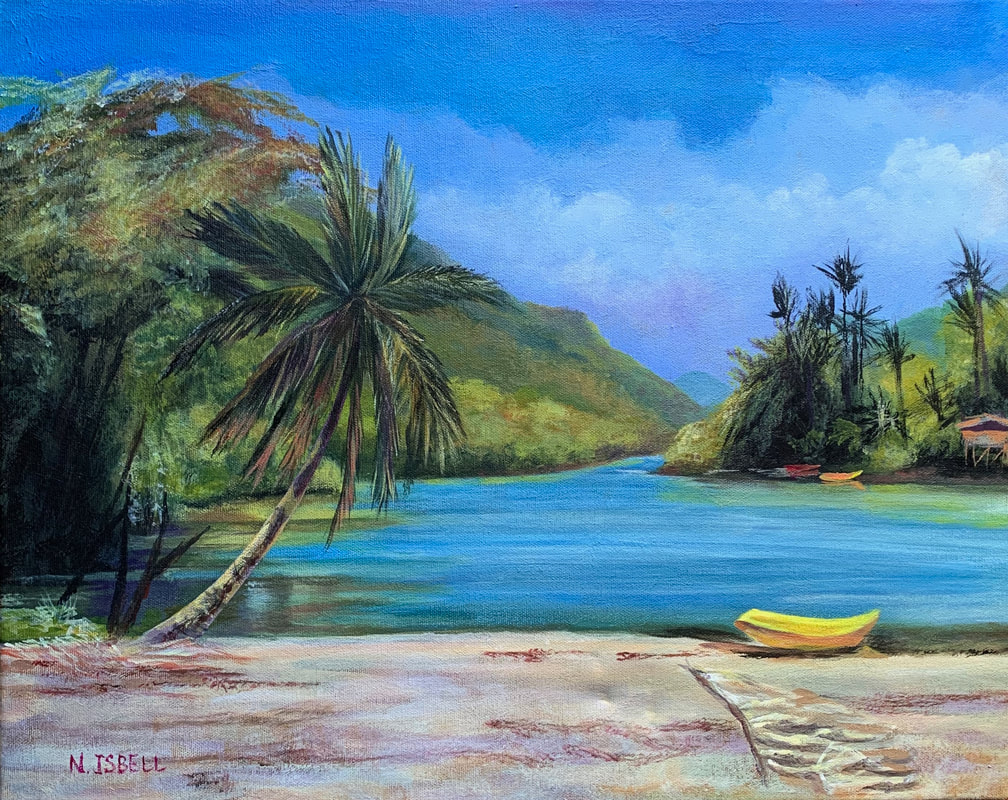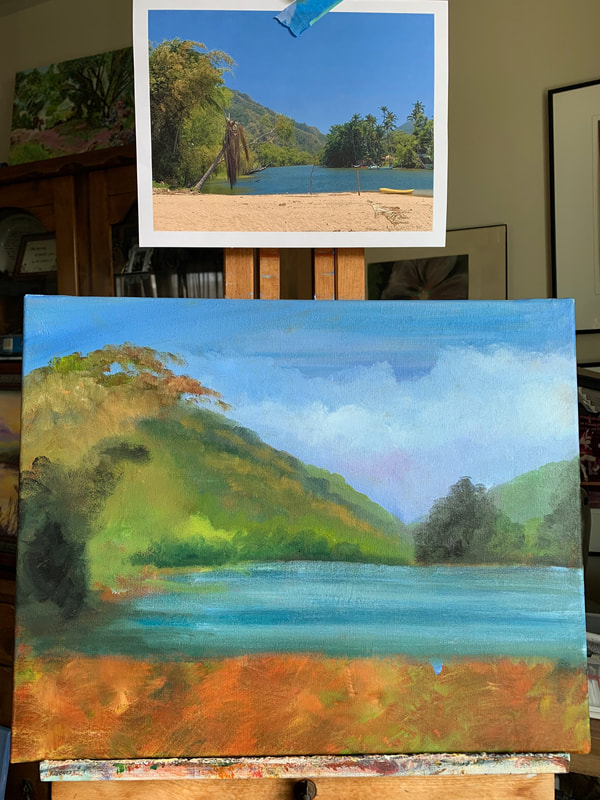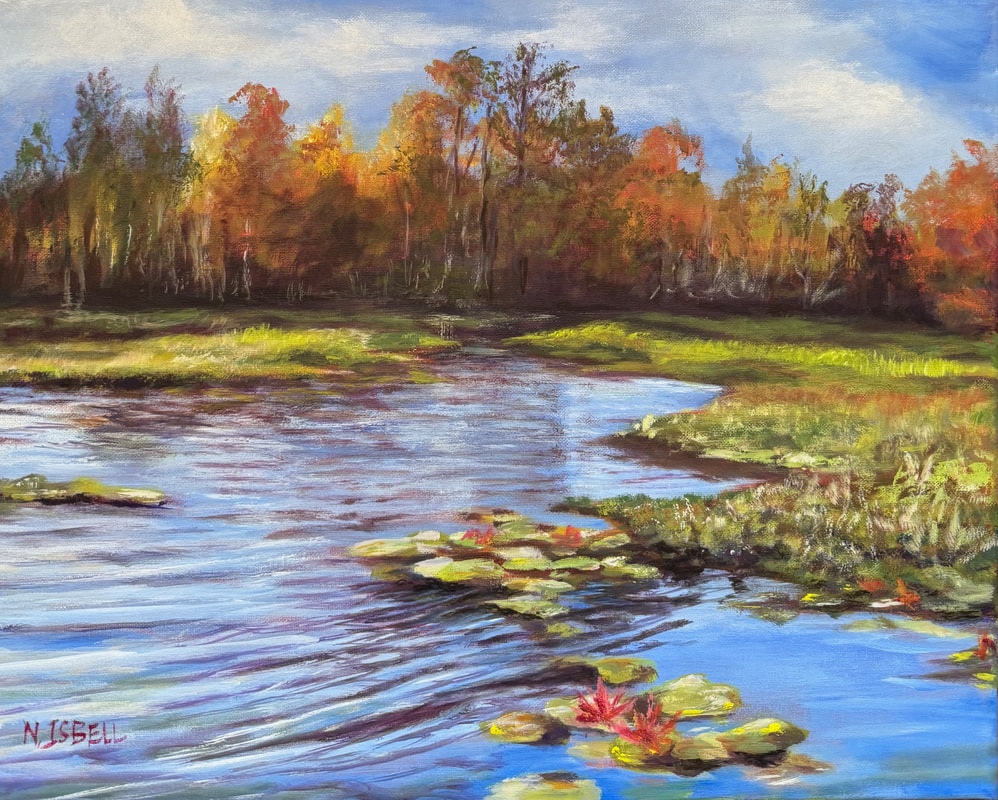|
I am going to explain one of the ways I paint an acrylic landscape. I am using one photo that I took as my reference. I like to tone my canvas with a complementary color to the dominant colors in the scene. In this example I use a reddish brown color because the painting is mostly blues and greens. Toning the canvas first is not mandatory, it is a personal preference. I like to do it because it serves as a warmup and gives me a chance to just paint freely. I took this photo of what I thought was a beautiful scene or could be if only the tree in it was still alive.  I used this photo and made a few changes. I added clouds, added reflections, made a live palm tree and just generally made it into my own vision. I started by blocking in the big basic shapes and covering the whole canvas with the first layer of color. I work out the placement of the basic shapes and am not concerned about the details. Since it is acrylic paint it dries quickly and I can add more layers right away and keep defining the shapes. I turn everything upside down to check my shapes as I go along. As I keep refining I go from big to small, from the least detail to the most. I want to make the scene mine so I exaggerate the colors and the values a bit in this, and bring the tree back to life. This is the fun part, where I use my own ideas and personalize it. For a landscape I usually start adding the details and embellishments in the "distance". I keep moving "forward". Then I move all around and add the final layers anywhere I feel it's needed. This is just one of the many ways to approach a painting.
0 Comments
I have my idea for a new painting, now how do I get started? I can use reference images, photos I have taken or found. I could make something up from my imagination and or memory, or I could look at something right in front of me, maybe a still life or a scene somewhere. My choice, my freedom. I have tried all of these approaches and they are all valid and each has their own challenges. I am going to rank them , in my opinion, from easiest to least easy.
OK this is all just my subjective opinion but I think the easiest way to start a painting is with a photo that is ready to go. The composition is already there, the subject matter has everything needed, so I only have to copy it. It is best if I took the photo. The reason I think this is the easiest is because it is already a two dimensional image and I am transcribing it to another 2D image. Also it doesn't need editing, that is taking out or adding other elements to the scene. The more common example and next in my hierarchy is to use a reference photo but make changes to it. It could be adding or removing elements, maybe combining parts of more than one photo. It could also be changing the colors. In other words it is not a copy of the photo but the photo is used for inspiration. The next way of working is to use real life for the reference instead of a photo. Within that category looking at something in a controlled environment, such as a still life set up, or a model is easier than being outdoors where the light is always changing, such as en plein air. The most difficult way of making a painting, for me, is without any reference. Of course that is assuming I am attempting realism, abstract painting is a whole other topic. Painting without any reference requires using only my memory and imagination. It is the ultimate in creativity. The more I paint something the easier it gets to paint it without reference. The painting below was painted from imagination. Since I have recently started "teaching" how to paint I am asking myself "Well, how do I make a painting? How do I decide what to paint? How do I proceed, where to start?" I have been painting for so long that I just go for it and feel my way through, but now I need to break it down in order to convey the "How" to others. So that is what this is about, my thoughts on how to make a painting.
The first thing I need to determine is what to paint. That seems obvious yet it's not. I have spent 50 years creating various forms of art, illustrations, murals, paintings, greeting cards, menus etc. for clients, not for me. The goal was to complete the assignment, satisfy the boss, produce the painting the client wanted. Of course I had to also please myself with the outcome, but it was more of a "team" effort. The client had a vision that I was to fulfill. And that is not necessarily an easy task. But at least there was not the question of what to paint. I am fortunate that I have been able to be paid for doing something I enjoy doing. But after being at a job site, standing on ladders and scaffolding, hauling materials in and out, painting on a time schedule, painting was work, not pleasure after all. So I never just painted for myself in my free time. Now I am starting a relatively new phase of my painting life, painting for myself. I ask myself OK, so what do you want to paint? Why do you want to paint, I mean, what's the point? Why paint? Always before the motivation was to earn a living. After awhile I realize that painting is truly something that I not only want to do but it is actually a need. I'm not sure what the need is. They say a true artist expresses their feelings through their art. I don't know if I do that or not, but I have been told that so much that I question if I am a true artist. Am I legitimate? Can I call myself "An Artist"? Should I say I'm "A Painter" instead? I know I am a painter, but does that make me an Artist? Maybe I'm still "only" an illustrator. I looked up the definition of an artist and there are so many different descriptions and not a definitive answer. So I have determined that it doesn't matter what I call myself, I just know that painting is what I do. Looking back I can see that it has been a lifelong pursuit and a personal goal. At this stage in life if I can produce a painting that I like that is all that matters. I am past the stage of pleasing others, I am trying to please me. Maybe after 50 years of painting for a living I can finally call myself an Artist. So back to the question what to paint? How do I decide? There are so many possibilities that it can be overwhelming. I have started narrowing it down to "Beautiful Scenes". OK and yes Beauty, like Art is in the eyes of the beholder. So my "Art" is my personal way of attempting to capture with paint a moment of what I think is Beauty. I have been on the lookout for images of beauty that get my attention. I take pictures of everything that I think might be a possible painting. I make a mental note whenever I see something that entices me. That is how I start a painting. It's a newfound freedom with an infinity of possibilities that I am gradually narrowing down. I am making a collection of ideas, it's called possible paintings. Back before computers I used to go the the library and check out a "Morgue File" of clippings of images. They were arranged by category and used for reference. Now I have my own file for that purpose. So though it may seem obvious, getting the idea of what to paint is really the first step to making a painting. Choosing the subject matter of a painting is all up to me. I am my client and I get to please me! |
NancyArchives
January 2025
Categories |






 RSS Feed
RSS Feed